Thick descriptions
The Conflict of Dividing Attention between the Individual Animal and the Global Process of Climate Change at Rotterdam Zoo
By Vincent Reijnders.
Introduction
This paper will present the findings of a field trip to Rotterdam Zoo. It will embed the observations into a broader, theoretical framework on thinking about zoos. The observations are analysed from a multitude of perspectives; including thoughts on looking at animals and the animal gaze, zoo design, the tension between individual animal welfare and their species in light of the notion of the Anthropocene, but mainly from the perspective of what Haraway calls ‘becoming-with’ (4). She argues that every organism is connected in what she calls “material-semiotic nodes or knots in which diverse bodies and meanings coshape one another” (4). What is more, the connection comes prior to the individual organism, every organism is constituted in “intra- and interaction” (4). This line of reasoning is backed up by biologic evidence that all organisms are in fact always constituted in relation to many others, blurring the lines between an individual and a community of diverse organisms. Haraway’s way of thinking on intra-action and ‘becoming-with’ is backed up by biologic evidence that all organisms are in fact always constituted in relation with many others (3-4). Central to her argument is the idea of the ‘encounter’: human and nonhuman organisms meet, and an obvious place where this can happen is at the zoo.
This paper focusses on one animal exhibit at Rotterdam Zoo: the polar bear exhibit. It uses this example to address the way the zoo has shaped the encounter between visitor (man) and animal (polar bear). It will examine this personal ‘meeting between species’ and how it reflects on zookeeping and human responsibility in the age of the Anthropocene. The main question is how Rotterdam Zoo combines attention for their individual animals, in this case the polar bears; and for the process of climate, which is global and affects all species. The polar bear has long been associated with and used for campaigns on climate change and has become a symbol for global warming and the destruction of animal habitat. Rotterdam Zoo also uses the polar bear as a symbol in their posters on climate change.
This paper takes the form of a thick description. Based on my observations and theoretical reflections I will argue for a revaluation of the polar bear exhibit. Rotterdam Zoo needs to stress the entangled nature of their animals, their visitors and the entire planet, in order to play a more effective role in combatting climate change through education, while also improving their animals’ welfare.
What is a Thick Description
In his article on thick descriptions, Geertz writes that:
The second law of thermodynamics, or the principle of natural selection, or the notion of unconscious motivation, or the organization of the means of production does not explain everything, not even everything human, but it still explains something [ … ] . (1)
As a social anthropologist, Geertz is concerned with the practice of ethnography. It is from this perspective that he addresses the difficulties surrounding scientific explanations. He argues that “[n]othing has done more [ … ] to discredit cultural analysis than the construction of impeccable depictions of formal order in whose actual existence nobody can quite believe” (5). In short, no scientific theory or interpretation can or should explain everything – or every aspect of something. In ethnography, theories are used as discourse that can help define and relate to the object of study (8). The starting point of a thick description is thus never a theory, but a “state of general bewilderment as to what the devil is going on” (8). Theories are interpretative tools that can be borrowed from other disciplines and used until no longer useful, both within a particular study and within the field as a whole.
Geertz defines the practice of ethnography through a semiotic concept of culture: “a multiplicity of complex conceptual structures, many of them superimposed upon or knotted into one another, which are at once strange, irregular, and inexplicit” (4). Ethnography is a search of meaning and is descriptive rather than prescriptive. It provides a context, an interpretation, in the form of a fiction – not false, but constructed (4-5). As such, ethnographers work from the observed towards an interpretation instead of from theory to data (7). The notion of ethnography has recently been expanded to include the nonhuman, which is called multispecies ethnography (Kirskey, Helmreich, 545). They argue that “[c]reatures previously appearing on the margins of anthropology – as part of the landscape, as food for humans, as symbols – have been pressed into the foreground” (545). Their relation to the human is still apparent, however, since all these organisms gain their relevance through their interaction with the human, social world. Multispecies ethnographers thus study “contact zones where lines separating nature from culture have broken down” (546) in some way. A possible example of this is the zoo. Aligned with Haraway’s ‘becoming-with’, the thick description is thus the right format for this exploration.
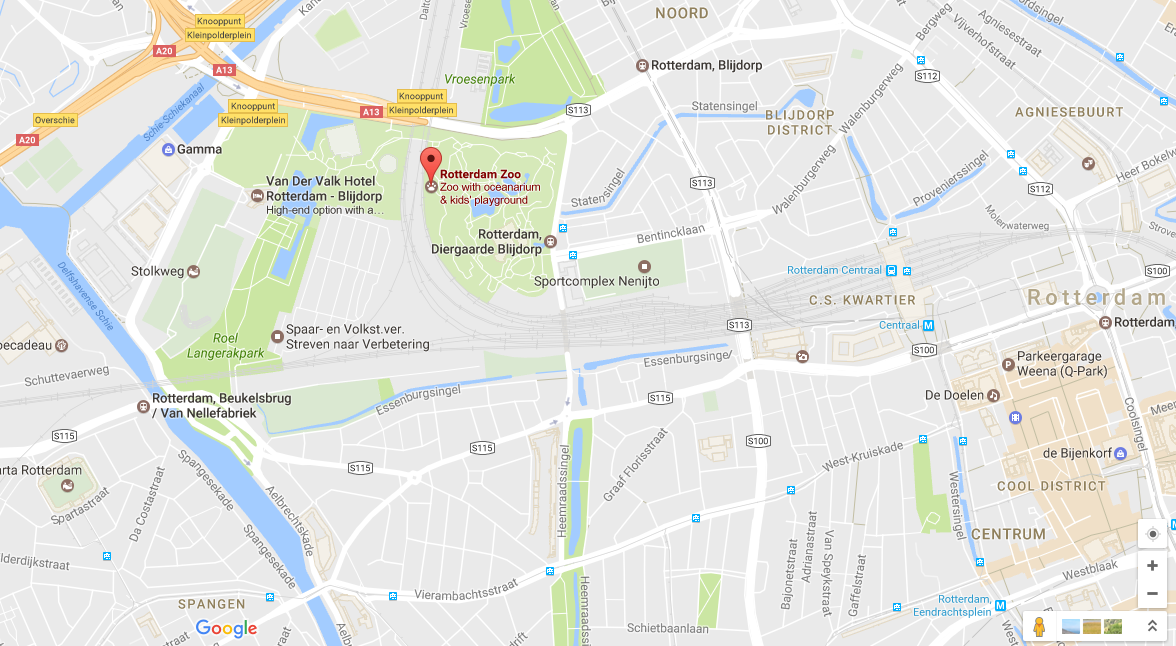
Rotterdam Zoo
Rotterdam Zoo – Diergaarde Blijdorp in Dutch – at the city of Rotterdam, is over 150 years old and with approximately 1.5 million visitors a year one of the busiest attractions of the country (Zwinkels et al., 67). Uddin describes zoo animals as “city dwellers in their own right” (4) and the zoo as part of a “bourgeois civic culture that include[s] museums, libraries, theatres, and concert halls” (6), so it is only right to focus on what is geographically the largest city-based zoo of the Netherlands. The only competition in terms of visitors is Artis in Amsterdam, but that zoo is significantly smaller in size. Only a couple of minutes walking distance from Rotterdam Central Station, the zoo is located within the city centre and surrounded by the urban landscape. A railroad cuts through the park, and skyscrapers and neighbouring houses and roads are seen behind various exhibits. The zoo is framed and fragmented by the city that encapsulates it.
A Sad Spectacle
I spent most of my time at the polar bear exhibit, including the path leading up to it and the immediate surroundings. I collected my data through observation, which included taking pictures and reading the information provided by the zoo by means of banners, posters and their website. Since a thick description should provide a detailed account of a material-semiotic knot or object and strive to disentangle the various processes or strands that are involved in the production of this object, I have kept my object of research limited to one exhibit.
A prominent critic who has written on animal observation at the zoo is John Berger. He argues that in modernity animals are reduced to an observable object: “The fact that they can observe us has lost all significance” (27). It is therefore that the human and the nonhuman have become separated and the relationship has become unilateral. According to Berger, the emergence of the public modern zoo coincides with this development. As such, they are a testament to the disappearance of the dual relationship between man and animal (30). Berger problematises the observation of animals precisely because of this loss of duality. Even though a zoo invites its visitors to look at the animals “the view is always wrong. Like an image out of focus” (33). Despite the zoo’s function to display animals, the public cannot encounter the animal behind the fence as anything more than an object, since the animal gaze is no longer of interest to the visitors and has therefore become unable to meet the human gaze. Moreover, the visitors are completely unaware of this loss. It explains, however, why “[t]he zoo cannot but disappoint” (37). This feeling of disappointment, or rather sadness, is the starting point of my observation.
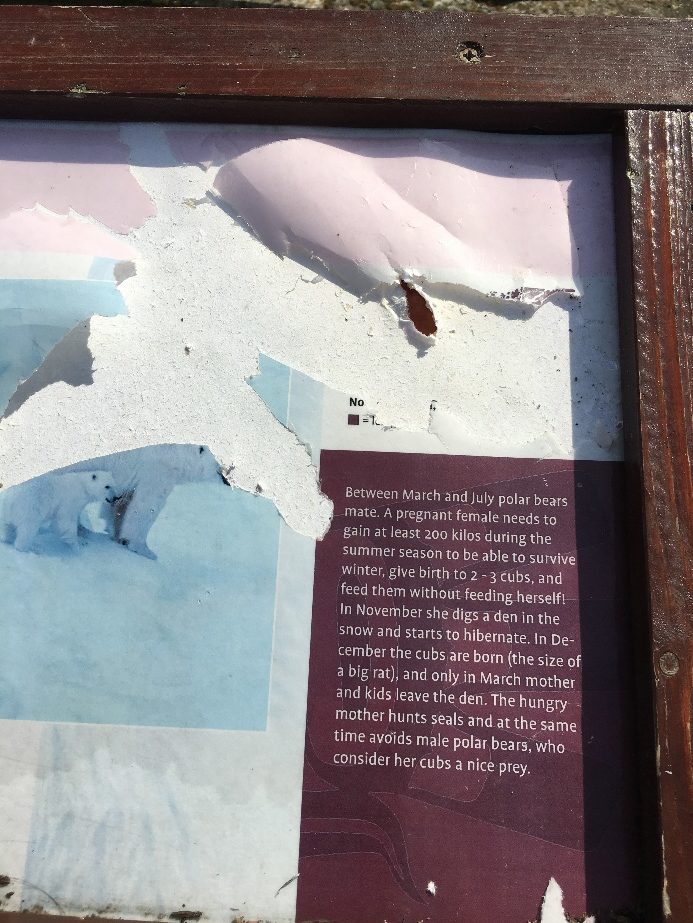 Rotterdam Zoo has positioned its exhibits in such a way that most, if not all, are accessible for viewing from more than one location. The polar bear exhibit is surrounded by its pathway and viewing area for approximately 50 per cent. This enables the visitors to view the polar bears from almost all sides. There are thus two ways leading up to this specific viewing area, one from the left and one from the right, depending on the taken route. I arrived from the right, which is an elevated pathway that gives the visitor an overview of most of the exhibit. At the highest point there is a banner which should detail some information on polar bears, as is the function of these banners throughout the park. This banner, however, was broken. More specifically, the sheet of paper attached to it was torn, making the information largely unreadable. The exhibit itself consists of rugged terrain with an artificial pond in the centre. This ‘pool area’ is walled off with glass walls to allow visitors to see what is going on underwater. This part of the exhibit is connected to a semi-indoor viewing area that is deliberately constructed on a lower level than the rest of this route. There is also a small amphitheatre-style sitting area that is on an even lower level.
Rotterdam Zoo has positioned its exhibits in such a way that most, if not all, are accessible for viewing from more than one location. The polar bear exhibit is surrounded by its pathway and viewing area for approximately 50 per cent. This enables the visitors to view the polar bears from almost all sides. There are thus two ways leading up to this specific viewing area, one from the left and one from the right, depending on the taken route. I arrived from the right, which is an elevated pathway that gives the visitor an overview of most of the exhibit. At the highest point there is a banner which should detail some information on polar bears, as is the function of these banners throughout the park. This banner, however, was broken. More specifically, the sheet of paper attached to it was torn, making the information largely unreadable. The exhibit itself consists of rugged terrain with an artificial pond in the centre. This ‘pool area’ is walled off with glass walls to allow visitors to see what is going on underwater. This part of the exhibit is connected to a semi-indoor viewing area that is deliberately constructed on a lower level than the rest of this route. There is also a small amphitheatre-style sitting area that is on an even lower level.
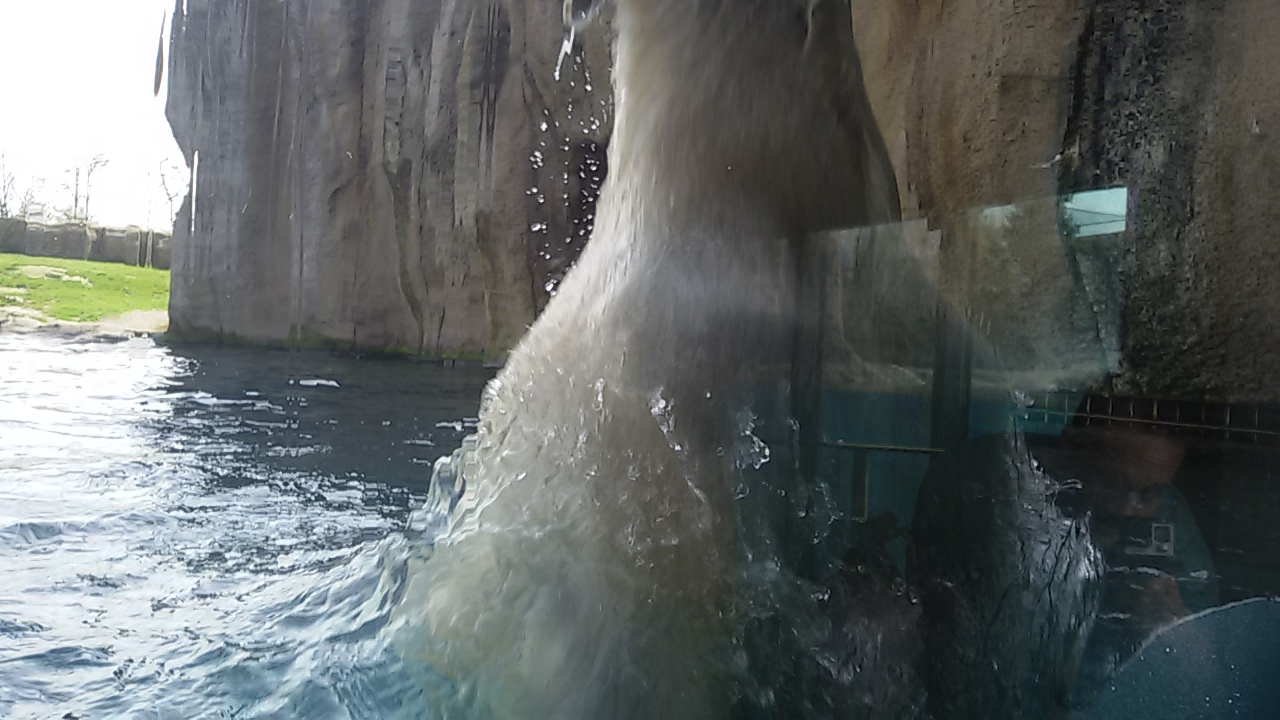
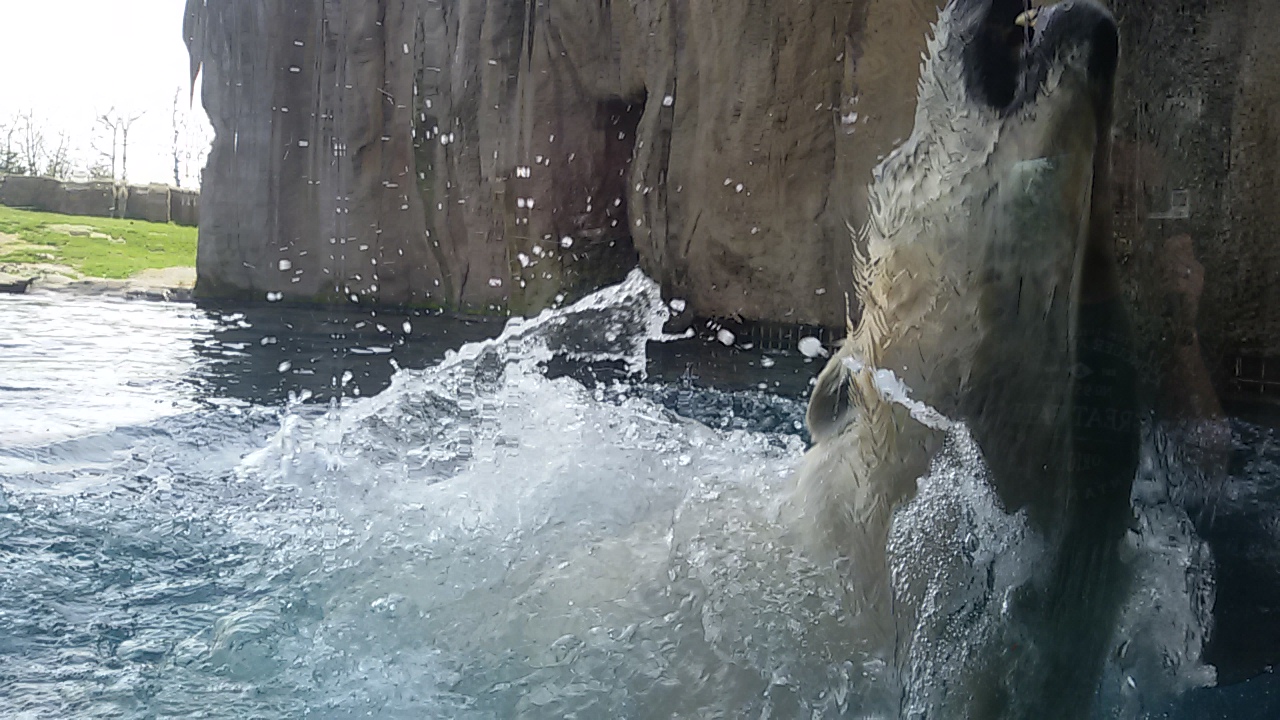
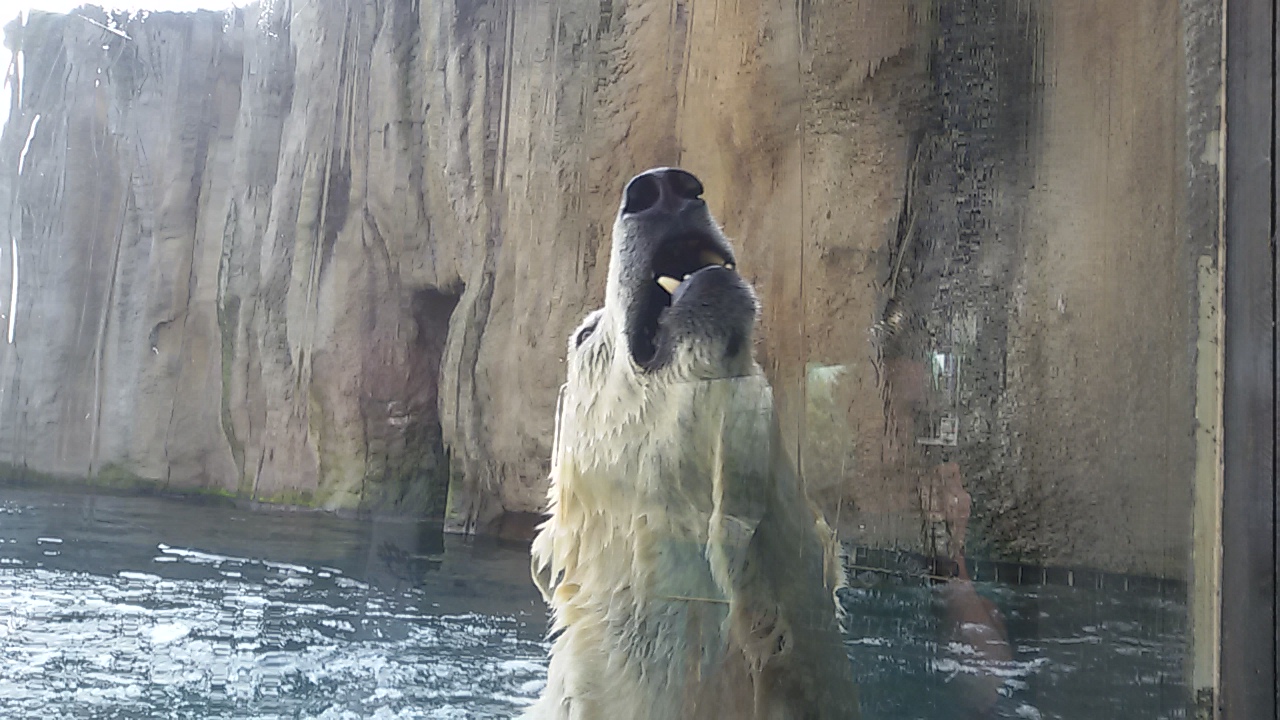
The visitors viewing the polar bears at that time were mostly bundled together at the glass wall that was still on the ‘main route’, with only a handful of people standing outside or sitting further down. The exhibit itself contains no actual ice, which makes the basin of water most resemble the natural environment of the polar bears. One of the polar bears in particular, was in the water almost the entire time of the observation, which lasted around 30 minutes. He or she kept jumping up out of the water towards something invisible to the spectators from that angle. There is a possibility it was part of what is called ‘environmental enrichment’; in this case some kind of toy placed there as part of “what Hediger has called ‘occupational therapy’” (Keulartz, 18). Heini Hediger was instrumental in the development of the elaborate, scientific and managerial approach to animal welfare in zoos; and, according to Keulartz “[a]nimal training is an important component of animal enrichment programs as it facilitates exercise and mental stimulation” (20). Whatever it was, it made the polar bear jump up repeatedly right at the edge of the basin near the glass wall. This provided quite the spectacle, especially for the younger viewers. When I later walked out of the indoor area onto the second outdoor path that enables viewing, I could make out some kind of rail placed immediately above the glass wall. It was connected to the indoor building and therefore out of the viewers’ eyesight when inside, but even from the outside it was impossible to determine what it was or why it made this particular polar bear jump up time and time again. It was definitely out of reach for the polar bear, and with no caretaker around, I left without knowing what it was.
I had visited this zoo once before, as a child with my parents. The only thing I can remember of that visit concerning polar bears is that this zoo indeed has them in their collection. According to Berger, “animals seldom live up to the adult’s memories” (33), which I can attest to, in the sense that I was struck by a profound sadness when witnessing these polar bears. Berger connects their artificial living spaces with “their tendency to bundle towards the edge of it” (35), since the edge represents the barrier between the artificial and the possibility of something more. He continues: “In all cases the environment is illusory. Nothing surrounds them except their own lethargy or hyperactivity” (35). Whereas most of the observed animals tended towards showing signs consistent with lethargy or boredom, including the other polar bears, the one I am highlighting here definitely displayed actions close to hyperactivity or even an obsessive-compulsive disorder.
My experience fits Malamud’s summary of Jean Stafford’s ‘In the Zoo’ from 1953, which starts at the Denver zoo, and more specifically, with a polar bear (313). Malamud describes the polar bear from the story as “pathetic” and its habitat as “grossly inappropriate” given the warm summer weather (314). The exhibit at Rotterdam Zoo struck me as rather small – especially from what I remember from my previous visit – and also somewhat unfit: no ice, shades of green grass and quite hilly. It was rather warm on the day of my visit, the 31st of March, with temperatures reaching twenty degrees Celsius, which made the polar bears look particularly out of place. Malamud focusses on the polar bear “ceaselessly shaking [its] head [indicating] what a zoologist would diagnose as the abnormality of stereotypy (repetitive animal behaviour that does not naturally occur and that indicates a disturbed state)” (314). The behaviour of the bear is then juxtaposed with that of the visitors: “Most of the zoogoers ignore the bear, confirming the frequent observation in zoo stories that, by and large, sloppily unobservant spectators miss more than they see” (314). From my perspective, the animal’s behaviour was showing signs of mental health problems; while the crowd pressed against the glass was mostly concerned with him or her jumping up frantically near the barrier, and described the animal as either scary or stupid.
Dividing your Attention
The spectacle of the jumping polar bear made me wander around the indoor area for a while, since I had trouble dealing with what I saw. It was at this point that I found a second ‘room’ within the indoor section. The entire indoor department was made to resemble a cage or house of ice. All of the walls were irregular, yet smooth and painted white. The ‘main route’ only leads visitors past the exhibit, where the animals attract their attention, so it was no surprise to see the other room almost completely deserted. Upon entering this second room, he or she is confronted with a makeshift theatre, complete with fake iceberg stools and a big screen TV showing footage of other polar bears. On the backside of the wall that separates this room from the main area are several big posters on climate change. They list the cause and effect of climate change; the efforts made by the zoo to stop and/or revert this process and what visitors can do to help in their daily lives.
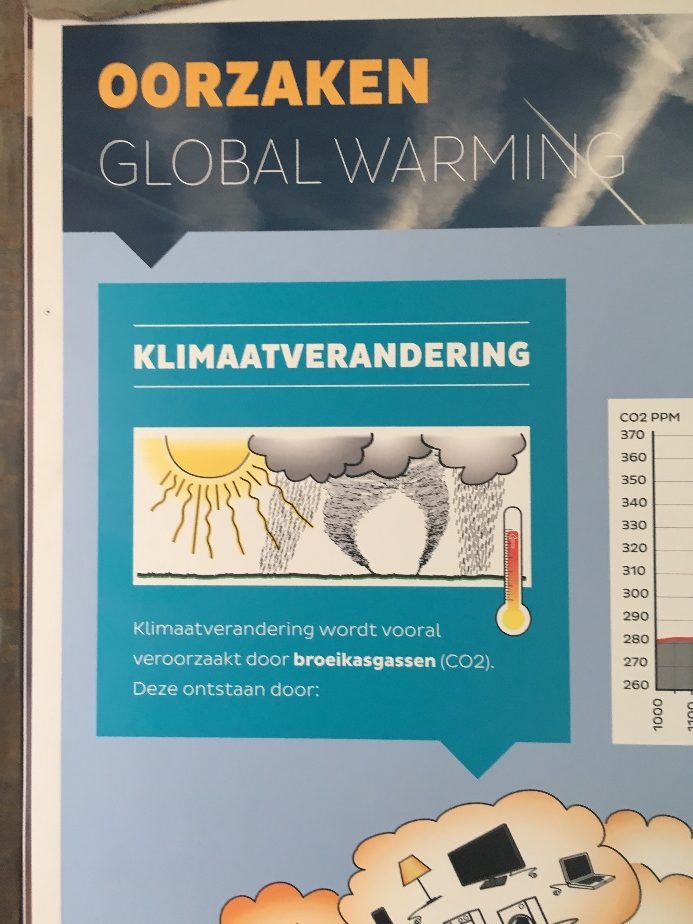
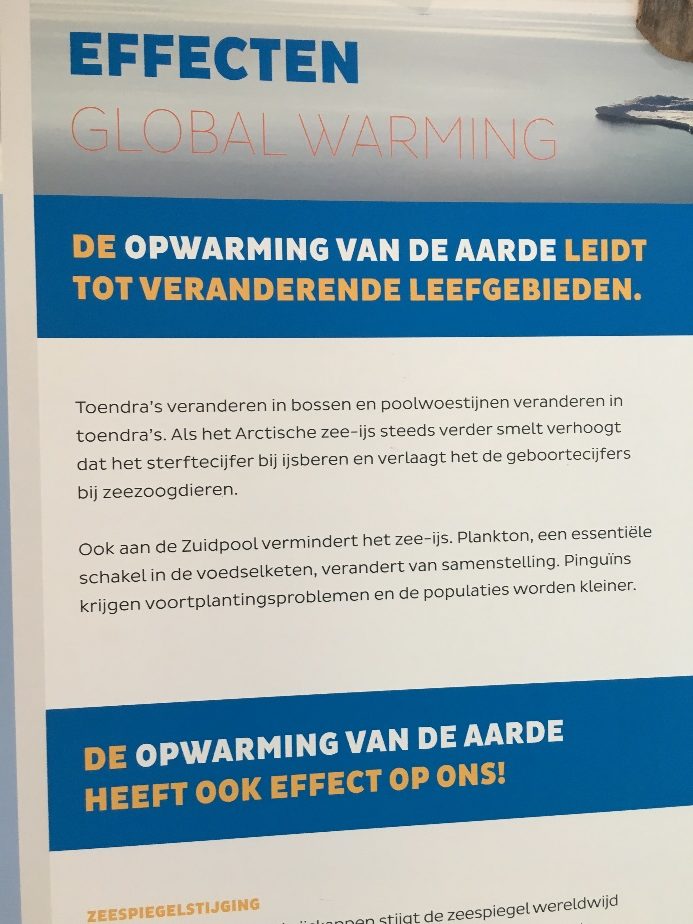
Zoos are primarily designed with the customer and not the animal in mind (Rothfels, 484). As Rothfels claims, “despite the rhetoric about scientific research, education, and, more recently, conservation, all these places have been built for recreation” (482). Zoological design is a well thought out process aimed at pleasing the customer. When the customer feels animals should be kept in their ‘natural environment’, zoos will strive to present their animals in their natural environment. However, they are judged by how well the visitors believe this, not by the wellbeing of the animals themselves.
The architectural plans of zoos comprise not only their exhibits, but also the viewing areas and walking routes, and also the gift shop, entrances and restaurants etc. Therefore, this specific indoor viewing room is also a consciously designed part of Rotterdam Zoo. As Salih argues, “[z]oos are all about looking” (300), and this statement is not limited to the animals. The entire zoo is constructed to make the visitor look a certain way, and therefore not look somewhere else (300). Whereas Salih applies this reasoning to different animals and forms of suffering, the same logic applies to looking at polar bears or at large posters on climate change. Apart from the physical impossibility of viewing both at the same time, they also represent two separate ways of ‘looking’ at animals and the nonhuman in general. On the one hand, there is the animal exhibit with the polar bear constantly jumping up out of the water; and on the other hand, there are a number of posters informing and instructing the visitor on climate change. Whereas the animals draw the attention of most visitors, aided by the route the zoo has laid out for the visitors – guiding them to the viewing area; the posters on climate change target the visitor directly and imply them in the global process of climate change. The posters address the visitors and ask them to become involved. The polar bears represent the disconnection between human and nonhuman whereas the posters try to represent a ‘coming-together’ of species and in doing so seek to reconnect the organisms of earth. However, the visitor, as human, is still defined as unique and different to all other species.
The first tension that arises between the polar bears and the posters is that of individual animals versus larger communities such as entire species. Keulartz explains these two sides as two “ethical frameworks” (1):
the individualistic framework of [ … ] animal ethics in which species are of little or no moral relevance, and the holistic framework of environmental ethics that tends to make the rights and welfare of individual animals subordinate to the interests of the greater whole of which they are part, such as species or ecosystems. (1-2)
Keulartz describes a long history of tension and struggles between both sides, and while Rotterdam Zoo includes polar bears in their plea for awareness and action regarding climate change, no connection is made with their own animals, whom the visitor has probably just seen. It remains unclear how Rotterdam Zoo will bridge the apparent gap between the welfare of their own animals and their goal of combatting climate change. Keulartz argues both perspectives are entangled and mutually beneficial, but the zoo does not present a method for bringing the two together (16).
The second tension is that of ‘becoming-with’ in the age of the Anthropocene. The Anthropocene is “an emergent idea, which posits that the human species is now the dominant Earth-shaping force” (Baskin, 9). Humanity has become the driving force behind climate change and its effects on nature. The Anthropocene is presented as an epoch, but it is actually closer to an ideology or paradigm (10-11). As such, it can be used to legitimise further human impact on the planet in order to halt and/or reverse this destructive process, while simultaneously stripping all that is nonhuman of its agency (14, 17). As Baskin argues, the concept “draws ‘the human’ into ‘nature’ but not the multiple and unequal social values, relations and practices of power that accompany actual humans” (16). In addition to this, it disregards diversity found in nature and the intra-active relation between humans and nonhumans. It limits the bio-community to two highly reductive concepts. In their poster presentation, Rotterdam Zoo adheres to this worldview by placing its visitors separate from their animals, both spatially and conceptually. Effects on wildlife and effects on humans are listed separately and especially the effects on humans are presented as the definitive reason to become involved.
Conclusion and Suggestions
My visit to Rotterdam Zoo has left me wondering what is more of a tragedy. It can be the struggling polar bear that captivated the attention of the visitors who were visiting the zoo for recreational purposes, the process of global warming which affects both humans and nonhumans; or the almost complete lack of integration between the former two at the polar bear exhibit and viewing area at Rotterdam Zoo, or a combination of the three. The individual animals and the posters are both meant to capture the attention of the visitor, but in completely different ways. In order to more effectively integrate animal welfare and visitor recreation with climate change policies and visitor activation, Rotterdam Zoo should strive to present their animals and their policies as an entangled material-semiotic knot, emphasising their ‘becoming-with’. It should address the visitor as ‘essentially connected’ to animals, as well as to the global community of humans and nonhumans, in order to formulate and advocate policies to combat global warming in an inclusive way.
The following can be read on the website of Rotterdam Zoo: “We willen onze bezoekers laten meebeleven hoe mooi en bijzonder ijsberen zijn en daarmee het besef vergroten van de invloed van klimaatverandering op deze bedreidge dieren”, which is a positive message that signals awareness of both climate change and its consequences. However, it fails to address how Rotterdam Zoo intends to achieve this, and whether it is even a viable method of gaining awareness in the first place. The polar bear exhibit hinges too much on the recreational aspect of the zoo, most of its design is aimed at showing the individual animals, and the information on global warming is presented as only an afterthought for those visitors who actively seek out such information.
Works Cited:
Baskin, Jeremy. “Paradigm Dressed as Epoch: The Ideology of the Anthropocene.” Environmental Values Vol. 24 (2015): 9-29.
Berger, John. Why Look at Animals? 10th ed. London: Penguin Group, 2009.
Geertz, Clifford. “Thick Description: Toward an Interpretive Theory of Culture.” The Interpretation of Culture: Selected Essays (1973): 3-30.
Haraway, Donna. When Species Meet. Minnesota: University of Minnesota Press, 2008.
Keulartz, Jozef. “Ethics of the Zoo.” Oxford Research Encyclopedia of Environmental Science.
Kirksey, Eben and Stefan Helmreich. “The Emergence of Multispecies Ethnography.” Cultural Anthropology Vol. 25, No. 4 (2010): 545-576.
Malamud, Randy. Reading Zoos: Representations of Animals and Captivity. New York: Macmillan, 1998.
Rothfels, Nigel. “Zoos, the Academy, and Captivity.” PMLA Vol. 124, No. 2 (2009): 480-486. <http://www.jstor.org/stable/25614288>.
Salih, Sara. “The Animal You See.” International Journal of Postcolonial Studies Vol. 16, No. 3 (2014): 299-324. <http://dx.doi.org/10.1080/1369801X.2013.851826>.
Uddin, Lisa. Zoo Renewal: White Flight and the Animal Ghetto. Minnesota: University of Minnesota Press, 2015.
Zwinkels, Juul, Tania Oudegeest and Michaël Laterveer. “Using Visitor Observation to Evaluate Exhibits at the Rotterdam Zoo Aquarium.” Visitor Studies Vol. 12, No. 1 (2009): 65-77. <http://dx.doi.org/10.1080/10645570902769142>.

